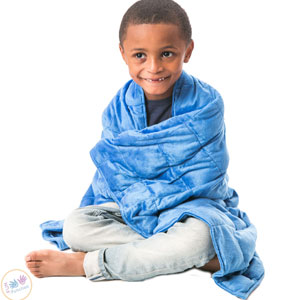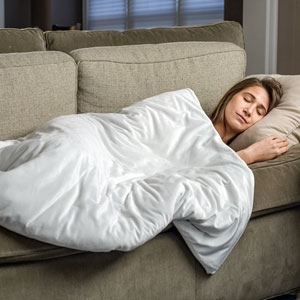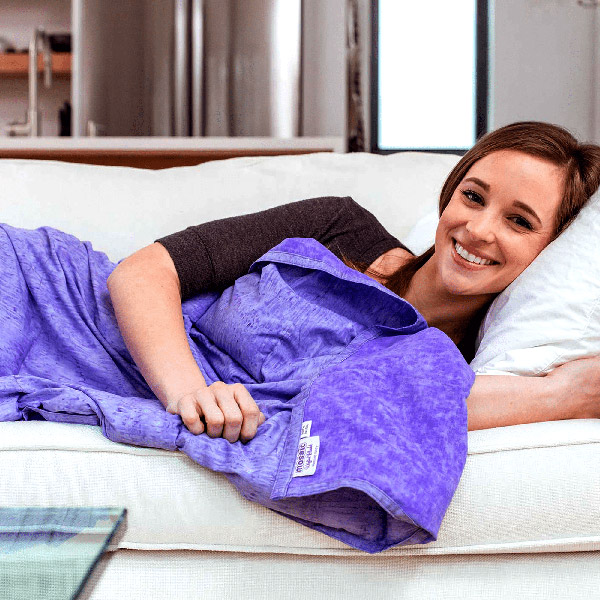Weighted Blanket Fillers: The Complete Guide
For transparency, I wanted to let you know that this page contains affiliate links. What is an affiliate link? In a nutshell, as an Amazon and Shareasale affiliate if you make a purchase after clicking a link on this site, I may receive a small commission, at absolutely no extra cost to you! Why do I have affiliate links on my site? Running a site like this and producing quality free content can be surprisingly time and resource intensive. Earning some affiliate income allows me to offset and justify the time and cost involved in producing content, paying for hosting, maintaining the site etc.
If you are considering a weighted product for yourself, a friend, family member or child: Please make sure you are well educated on the right weight to use, and whether use of a weighted product would be safe in your specific situation. If you are at all uncertain, please consult a qualified medical practitioner. Material provided on this site is for general informational purposes only and should not be considered a substitute for qualified medical advice (more info about that here).
Last updated: 22nd October 2019
If you want to make your own weighted blanket, you’ll be pleased to know that there are several materials you can choose as filler. And If you don't, but still want to know more about popularly used materials, read on.
The most popular options are plastic poly pellets and glass beads, and sand (a budget choice). And we’ll get into more detail about them shortly. People have even gone as far as using metal weights and dehydrated organic food, but you can only imagine how uncomfortable or noisy that could be if it's not done right.
There are many things to consider if choosing one, and they will influence more than just how heavy the blanket will be, or how should you take care of it.
I’ll explore a few options so that you can make an educated decision on your preferred weighted blanket stuffing.
What types of fillers are there for weighted blankets?
As said before there are 3 weighted blanket fillers that are most widely used; poly pellets, glass beads and sand, but there are also a couple more that you might see being used by some manufacturers.
It's also good to know that some manufacturers stuff their blanket's pockets with cotton, to even out the filling and make it less lumpy, which I think is an excellent idea, but this increases the cost a bit.
Here are some popular weighted blanket manufacturers who use varying types of fillers in their blankets:
Image | Name | Fabric | Filler | Decorations | Prices & Details |
|---|---|---|---|---|---|
Moonbow | Bamboo and polyester | Micro Glass beads | 2 colors | ||
Fun and Function | Soft Plush cotton / polyester | Polypropylene pellets | 1 color | ||
Luxome | Ultra plush minky or luxury bamboo | Glass beads (certified lead free) | Many colours available | ||
Mosaic Weighted Blankets | Cotton, minky and textured fabric choices | FDA compliant plastic pellets | Widest range of colors and patterns |
Anyway, without further ado, these are the most common weighted blanket fillers to use:
Plastic poly pellets
They are small round plastic beads with a pebble-like texture. They are commonly made from ABS virgin plastic which means they have not come into contact with toxins and other chemicals.
Note that if you have skin or sound sensitivities, then this may not be the best option for you. A smoother texture may be better, like the one glass beads provide, for example.
If you choose to use plastic pellets inside a cotton stuffing, it could help a bit with the noise they make, but be aware that they might feel a bit uneven if they aren't carefully constructed. Your blanket might end up being lumpy, and this could irritate you at night if you are sensitive to that type of thing.
If you use minky or fleece fabrics with plastic pellets, you’ll have a softer texture due to the thickness of the material. You might still be able to feel the rougher texture of the pellets, but you won’t necessarily see it.
Image | Brand | Summary of product info | Prices & Details |
|---|---|---|---|
ReachTherapy Solutions Poly Pellets | - Made in the USA - Non-toxic -Washer and dryer safe - Available in 5, 7, 10 or 20 lbs | ||
Victory Pellets | - Made in the USA - Very comfortable - 100% satisfaction guaranteed - Non Toxic and Hypoallergenic - FDA Compliant and BPA Free | ||
RolyPoly Plastic Pellets | - Made in the USA - Non-toxic, hypoallergenic, BPA free - Mildew and mold resistant - Machine washable - Durable |
Micro glass beads
From ancient times to the modern day, the making of glass beads remained an art passed on from one generation to another. Scientists, historians and archaeologists still can’t determine where the knowledge of bead making came from, possibly ancient Rome or Egypt, maybe Mesopotamia? Wherever it is from, one thing is certain: once the production of beads started, it never stopped.
The glass beads were mainly made for decoration, and still are. But now they also have a utilitarian purpose!
Micro glass beads and ceramic glass beads are the best option for filling your blanket if smoothness is what you’re looking for when you’re choosing your fillers. They’re texture is similar to that of sand. If you’re using glass bead fillers, you can be sure no bumps will appear as the beads are distributed evenly.
These beads are extremely tiny and have a similar look and feel to white beach sand or salt crystals. They kind of make me think of Xylitol, you know, the fake sugar.
They will feel much smoother inside your blanket too and are probably the best selection for people with any type of auditory, sensory and physical sensitivities.
They are also a bit heavier than their plastic counterparts, and therefore you’ll need fewer glass beads to achieve your goal than you would with plastic pellets. Great for someone who wants weight but not an extreme amount of bulk on top of them.
The glass beads are really tiny, and for that reason they need to be sewn into the blanket with extreme care.
If there's even a small hole in the blanket, the beads will easily fall out. A DIY blanket with glass beads shouldn’t be put in the washing machine. It’s better to wash it by hand than risk a ruined blanket or washing machine.
Image | Brand | Summary of product info | Prices & Details |
|---|---|---|---|
RolyPoly Glass Beads | - Made in the USA - Twice the density of poly pellets (so you need less) - Machine washable and dryable - Earth friendly alternative to poly pellets | ||
Pinwheel Blankets | - Premium quality glass beads - Made in the USA - Family and pet safe, non-toxic - Easy to measure - Buy back guarantee if not satisfied |
Steel shot beads
Steel beads are very strong, heat treated hyper-eutectoid steel micro balls. They're super easy to wash, as they usually don't retain a lot of dirt between them because of their smooth surface, and will just last about forever.
These beads are slightly larger in size than glass beads but are heavier, so you’ll need even less of them in your blanket, making them perfect for really thin pockets. It's also great that, because they're bigger, it'll be harder for them to leak through the stitches of the blanket.
The only drawback is that they can also be a bit lumpy and noisy.
Sand
Sand is a somewhat decent (and very cheap) way of adding weight to your blanket or quilt, though it’s not the favorite, as it brings lots of problems.
What you must know about sand is that it has some issues being a semi-organic material (unless it's some sort of processed desert sand, which may be better and costlier).

Sand doesn’t spread out as easily as glass beads or plastic pellets, and it is much harder to wash and dry than the non-organic fillers.
Sand will expand when it comes into contact with water and will bundle or cluster up inside the pockets of your blanket, causing large uneven bumps in your fabric.
It will take an exponential amount of time to dry and depending on the fabric you use, and the construction of the blanket, they will leak more or less faster in the long run, so you probably don't want to wash sand-filled weighted blankets a lot.
Weighted blankets constructed with sand are often some of the least durable, so be aware of that.
I’ll give you a little bonus filler you can use if you are closer to a river than to a beach:
Riverstone and smooth pebbles
As you can imagine these could be very cheap fillers to add weight to the blanket if going through a budget DIY route, but I'll tell you:
I wouldn’t really want to sleep under a weighted blanket filled with rocks.
Pebbles do however come in various shapes and sizes, and if you do wish to go this route, you’ll want to choose small stones that are the most uniform in shape and texture.
If not, the consistency will be rough, lumpy and irregular, there will be a lot of clatter when you move around under your blanket, and it might be quite uncomfortable.
What about weighted blankets filled with food?
What a great question. With a weird answer...
Yes, there are some great organic fillers you can use like dehydrated corn, beans, rice, barley and even dry pasta. They are inexpensive and of course, available everywhere.
But just remember, at some point or another you will want to (and you should) wash your blanket. This might not go down so well for a few obvious reasons.
You know that adding water to these edibles will expand them through the absorption process, leaving you with one big soggy mess.
They’ll also take forever to dry out, that is if they do. And if you’re that lucky, you’ll probably end up with a very strangely deformed blanket.
If you aren't lucky well... You'll wake up sleeping in soup.
The most significant disadvantage with food fillers is that they’re delicate, susceptible to mold, fungus, bacterial growth and insect infestation, and at some point, they will expire and rot. Not a pretty picture.
So, I don’t suggest going this route unless maybe you’re doing a fun science project. Or just want your blanket to last a month (or three if unwashed).
Based on all this information, I'd say you're probably better off using a long-lasting, durable, non-organic weighted blanket filler that won’t give you any hassles when trying to use, wash or store it.
Do you have to be careful with weighted blankets containing toxic chemicals?
The ‘poly’ in plastic poly pellets, stands for Polypropylene. A chemical compound that’s an artificial resin which is a polymer of propylene. It does have other uses such as in films, fibers, threads, or casting materials.
I know what you must be thinking. These plastic pellets must be covered in fire retardants, preservatives, PBA’s, plastic by-products and a whole range of other toxins and substances.
And yes, you may be right. With every non-natural product there is always the risk of toxicity but fear not, there is a bright side.
With strict regulations these days, manufacturers are obligated to follow strict guidelines and safety procedures during the manufacturing process.
Therefore, most commercially distributed fillers tend to be nonhazardous, chemical free, PBA free, hypoallergenic and safe to use externally.
For your peace of mind, you could ensure these items have been FDA approved by reading the label before you buy.
Bear in mind though, that with anything inorganic and unnatural, like plastic and glass beads, you must keep them away from children and they are certainly not safe to be ingested.
Sand and preservative treated food fillers also fall into the "unsafe to eat" category, so be aware of that too.
I've put a lot of research into finding out which manufacturers have the best weighted blankets in the market in 2019, so do check them out if you are looking forward to buying one!










